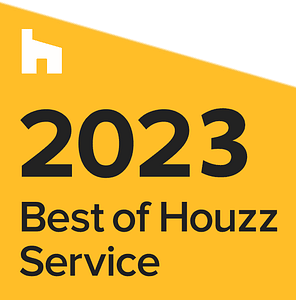In the journey of home maintenance and aesthetics, encountering damaged hardwood floors before and after can serve as a pivotal chapter in understanding the resilience and potential of your living space. This article aims to explore the intricate processes involved in reviving the beauty of your hardwood floors. We address the critical questions of repair vs. replacement and managing water damage. Then we will give ten invaluable tips for maintaining the luster and integrity of your floors. Should you call a flooring contractor or can you do it all on your own? Keep reading to get all the answers.
Table of Contents
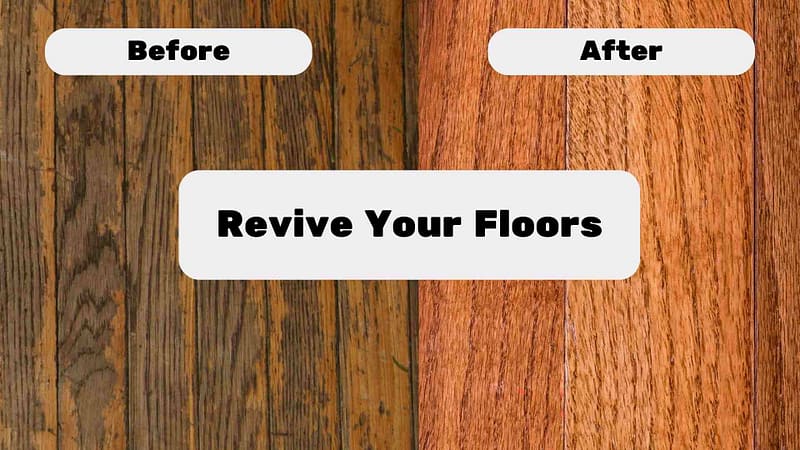
Repairing Severely Damaged Hardwood Floors: A Comprehensive Guide
To fix badly damaged hardwood floors, start with assessing the extent of damage. Minor issues can be addressed by sanding and refinishing, but severe cases may require replacing damaged planks. Professional evaluation is recommended to determine the best approach, balancing cost, aesthetics, and the floor's structural integrity.
Assessing the Damage
The first step in addressing badly damaged hardwood floors involves a thorough assessment. Professionals often look for signs of deep scratches, warping, or water damage. This initial evaluation is crucial, as it dictates whether the floor can be salvaged through refinishing or requires plank replacement.
Choosing Between Refinishing and Replacement
Refinishing is a preferred method for floors with surface-level damage. It involves sanding away the top layer and applying a new finish, which can dramatically restore the floor’s appearance. However, floors with extensive water damage or structural issues may need plank replacement. The decision hinges on the damage’s severity and the floor’s overall condition.
Professional Intervention vs. DIY
While some homeowners opt for DIY solutions, professional intervention is advised for severely damaged floors. Experts bring precision in matching wood grains and finishes, ensuring a seamless repair. Additionally, they can tackle underlying issues like subfloor damage, which DIY efforts might overlook.
Addressing severely damaged hardwood floors demands a balanced consideration of aesthetics, functionality, and expenses. The aim is to rejuvenate the beauty and integrity of your floors, whether by refinishing or replacement. For beach house owners, integrating this approach with our guide on top flooring ideas for beach houses could offer the best outcomes.
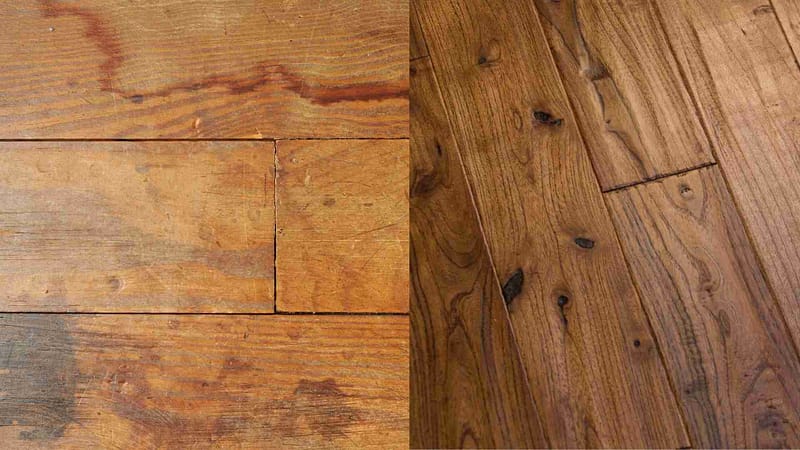
Water Damage Woes: Can Your Hardwood Floors Be Saved?
Yes, water-damaged hardwood floors can often be repaired, depending on the severity and duration of exposure. Quick drying, followed by sanding and refinishing, can restore minor to moderate damage. In cases of severe warping or structural harm, plank replacement might be necessary. A professional assessment is recommended to determine the best course of action.
Evaluating the Extent of Damage
The key to repairing water-damaged hardwood floors lies in promptly evaluating the extent of the damage. Floors exposed to water for a short period may only need drying and refinishing. However, prolonged exposure can lead to more severe issues like warping and mold growth, necessitating more intensive repairs.
The Repair Process
For minor to moderate damage, the repair process involves drying out the wood, which should be done as quickly as possible to prevent further deterioration. Once dry, the floor can be sanded to remove the top damaged layer and then refinished. This process can significantly improve the appearance of water-damaged floors and is cost-effective.
When Replacement Is Necessary
In situations where the hardwood has suffered from severe warping or the structural integrity of the wood is compromised, sections of the flooring may need to be replaced. This is often the case with extensive water damage where the wood has absorbed too much moisture, leading to permanent deformation.
Addressing water damage in hardwood floors requires a careful approach, focusing on quick action and accurate damage assessment. Whether through repair or partial replacement, restoring your floors from water damage is possible, bringing back the natural beauty and value to your home.
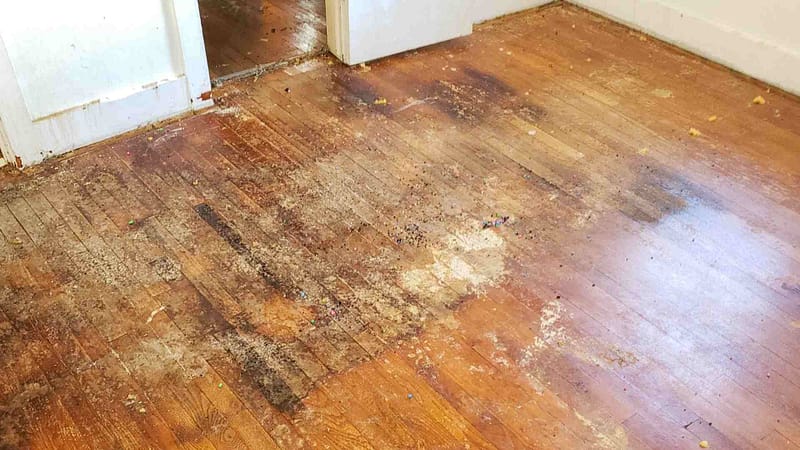
Breaking Down the Costs: Refinishing Versus Replacing Hardwood Floors
Refinishing hardwood floors is generally less expensive than replacing them. The cost of refinishing varies based on the floor's condition and size, but it significantly undercuts the expense of new materials and installation required for replacement. Therefore, refinishing is often the cost-effective choice for enhancing the appearance of hardwood floors.
- Refinishing hardwood floors involves sanding off the old finish and applying a new one, which can dramatically renew the floor’s appearance at a fraction of the cost of replacement. The process is labor-intensive but saves on the cost of new materials. The expenses associated with refinishing include labor, equipment rental, and materials like stain and varnish.
- Replacing hardwood floors, on the other hand, involves removing the existing flooring, purchasing new hardwood, and installing it. This process can be significantly more expensive due to the cost of new hardwood materials, which vary widely based on the type of wood, and the labor costs for installation. Replacement is typically considered when floors are extensively damaged or when a complete aesthetic overhaul is desired.
The decision between refinishing and replacing hardwood floors should consider both cost and the desired outcome. Refinishing is the more cost-effective option for floors that are structurally sound but need aesthetic improvement. However, for floors with extensive damage or for those seeking a completely new look, replacement might be the better, albeit more expensive, route.
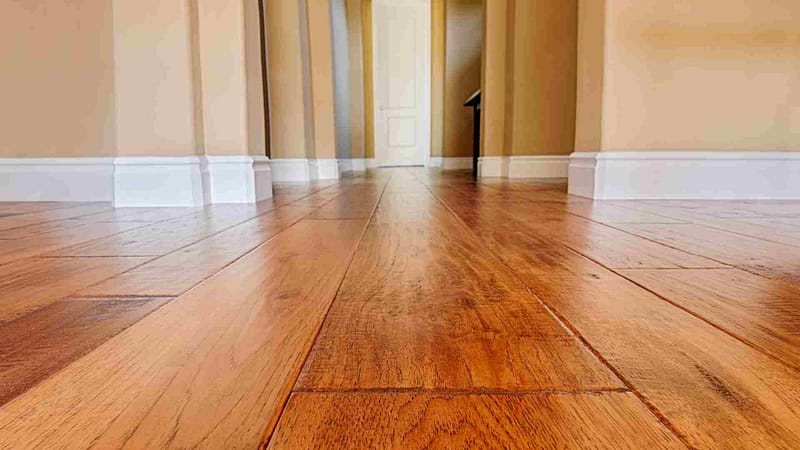
10 Essential Tips for Hardwood Floors
Regular Sweeping: Keep your floors clean by sweeping daily with a soft-bristled broom to prevent dirt accumulation that can scratch the wood.
Use Protective Pads: Place felt pads under furniture legs to avoid scratches and gouges when moving or using furniture.
Immediate Spill Cleanup: Wipe up spills immediately with a dry or slightly damp cloth to prevent water damage and staining.
Avoid Harsh Cleaners: Use cleaners specifically designed for hardwood floors. Avoid vinegar and water solutions, which can dull the finish over time.
Maintain Humidity Levels: Keep indoor humidity levels between 30-50% to prevent wood from expanding or contracting, which can cause cracks.
Rugs and Mats: Use throw rugs and mats at entrances to minimize dirt and moisture being tracked onto the floors.
Avoid High Heels and Sharp Objects: High heels and sharp objects can dent and scratch hardwood floors, so avoid wearing them or leaving them lying around.
Sunlight Protection: Use curtains or blinds to protect your floors from direct sunlight, which can fade and discolor wood over time.
Routine Refinishing: Depending on traffic and wear, consider refinishing your hardwood floors every 7-10 years to restore their shine and protect them from damage.
Floor Protectors for Pets: Keep pet nails trimmed and consider using pet booties to reduce scratches from pet claws.
Conclusion
To sum it up, caring for and repairing hardwood floors boils down to timely assessment, choosing between refinishing or replacing based on damage and cost, and sticking to daily maintenance routines. Whether dealing with water damage, scratches, or deciding on a refresh, the right approach can significantly extend the life and beauty of your floors. By following the outlined tips and strategies, you’re well-equipped to keep your hardwood floors in top shape, ensuring they remain a cherished feature of your home.






